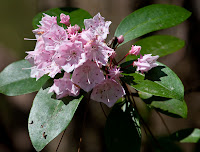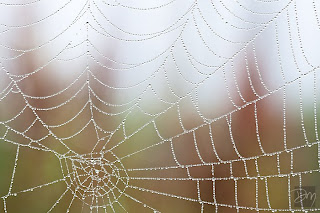(Click on images for full view... then use your Back button to return to the story. Enjoy)
This past spring, I was asked to make a photo for the 2010 Florida Forever calendar which is produced by LINC -
Legacy Institute for Nature and Culture - each year. The calendar features photographs made by "12 celebrated conservation photographers" of vulnerable properties in the queue for purchase by the Florida Forever Program. Having acquired and protected over 2 million acres over the past 20 years, in 2009 -- for the first time since its inception -- the Florida legislature approved NO funding for this program!
So, as part of the effort to get this program back on track, I was honored to accept this assignment. Seven Runs Creek in Walton County is a 15,000 acre parcel adjoining already-protected Nokuse Plantation to the south. I made 3 trips to the property in the spring and marveled at new wonders on each visit.
In February, John Moran and I explored the lowest section of the creek - as it loses its creekiness and turns into a braided cypress swamp that flows into the Choctawhatchee River. We started at a small roadside park (Hwy 81) where the shallow sand-bottom creek flows honey-colored through a lovely forest....misleading...

Soon we felt like Hansel and Gretel, trying to figure out which branch to take and gawking at twisted gnarly cypress knees.

As darkness approached, we wondered if we'd miscalculated.

This was no place to spend the night: huge cypress trees in a deep swamp, owls calling... were we even following the right course? We paddled faster and faster.

Finally arriving at Dead Lake Road, our aptly-named takeout, the sky had turned a deep purple. The familiar silhouette of a big split cypress stump standing near shore was a relief... and beckoned to be photographed (with a little light-painting). John took off on his bicycle in the dark to ride back for the truck while I waited with the boats. We were really bushed

when our heads hit the pillows that night.

In March, I returned, this time in the company of 'Turtle Bob' Walker who is one of the biologists managing the Nokuse Plantation, AND the Seven Runs property as well.

Bob hadn't seen much of the actual creek that winds through the acreage, but was game for a thorough exploration. By now, the mountain laurel and wild azaleas were in full bloom in the bottom lands.


We took a tour of the property, stopping to visit with a large diamondback rattlesnake who was friendly enough, and many of the resident gopher tortoises, who weren't so friendly... mostly we caught glimpses of their tail-ends as they dived into their burrows. We stopped on the creek at Bad Bridge (burnt to ruins) and waded upstream. I got caught up in making a photo of the creek with the mountain laurel as two hours floated by. When I noticed, dark was upon us. I was grateful for Bob's patience - he is the model of patience - and for this beautiful setting in which I thought I had made a calendar shot (opening image in blog), and for Bob's knowledge of the property and how to get back to his cabin in the dark.

The next day, we arranged to drop a truck at Bad Bridge and some fellow workers drove us to a field in the middle of the property. We were sort of following a map. As we ran out of dirt road, we had to be careful to avoid the small longleaf pines dotted across the field by plantation workers in the past year. This was formerly agricultural land, now being restored to longleaf forest. But the creek ravine and its steephead runs had never been very accessible or useful and weaved through this land relatively untouched for many decades.

We could see the dark lush creek woods across the field and got as close as we could. As we watched our ride rumble off in a dustcloud, it felt strange standing in an open field with paddles, kayaks and camera gear.
We hiked down into the woods and we came upon as lovely a spot on the creek as I could imagine. The early morning sunlight was bursting through the canopy. I was psyched. We had the whole day ahead to explore a creek that perhaps had never been paddled before. The water level had been bolstered by recent rains and appeared to be perfect. Bob was in his element. He knows most every creature and plant in this part of Florida, has a delightful sense of wonder and enthusiasm, and loves adventure. So, in spite of all the logjams, rafts of debris, and snakes, we had a blast. In fact, because of those things we had a blast. Bob taught me to smell the snakes before we saw them.

However, I was still a bit blown away when this cottonmouth fell from its perch and landed with a soft cool thud on my hand.

Even before it visually registered, my gut said "NOT GOOD!". It slid down onto my kayak and then into the water (as opposed to my lap). Bob got a good laugh and was disappointed I got off so easy.


He challenged me to catch the next one in my boat. I did hop out of my boat anyway, to try to get a photo. The water moccasin was cooperative enough, but the water was flowing so fast and there was so much underbrush and debris, I couldn't get in position for a good shot. We saw and smelled many snakes that day... and took in many other wonderful sights.

Bob was thrilled when he found a healthy cluster of a rare plant called Primrose Butterwort (not pictured), and again when we turned up an Eastern Dobsonfly larva. We both were sorry to see old Bad Bridge, but made a pact on the spot to paddle the one remaining section of the creek in the near future.

Preserving the gopher tortoise, a primary mission at Nokuse Plantation and the Seven Runs Creek tract is another whole story of its own, but I'll just say, I couldn't have been with a better tortoise guide than Turtle Bob. We had scoped out some burrows the day before and I had a great opportunity to photograph one of the endangered gopher tortoises in the evening after our adventure on Seven Runs Creek.
(Here's a link to the Nokuse story).

Following through on our pact, we explored the final segment of the Creek in April. This time our wives, Crystal and Leslie joined us... after hearing about all the snakes and stuff, they just couldn't resist. So this time we put in at Good Bridge. (You knew there had to be a Good Bridge if there was a Bad Bridge... such creative names too!) And yes, Good Bridge is still functional, although it has a locked cable across it. We left a vehicle in the same field of mini longleaf pines for our takeout. The creek was beautiful as ever, snaking through these bottom-lands with tributaries (the seven runs) pouring in from left or right along the way.

This trip a snake did fall into my lap. I saw it moments too late hanging on a branch above a logjam. My kayak rammed the debris as I caught hold of an overhanging limb and I was locked in by the strong current. There was the snake, fortunately this time, a big brown water snake, inches from my face, right over my lap. I couldn't get my boat out of the way so the inevitable happened. Having a close encounter with a human face no doubt startled the snake. Only one escape route: fall into the water. Only the water wasn't there anymore. Knowing that he was non-venemous didn't diminish the experience of having a flipped-out snake writhing frantically on my lap, and with both hands holding branches to keep me from capsizing, I couldn't even snatch the snake into the creek. By the time I got the boat out of there with Crystal's help and got out, the snake was under my seat and not willing to come out. Ultimately, ol' Turtle Bob arrived and with glee,

didn't hesitate to reach into the dark crack under my kayak seat -- trusting me when I said "I think it's just a watersnake, Bob". He gently pulled the scared snake out and after showing it around and pointing out how unagressive it was, released it back to the creek. We all got pretty good at smelling out the snakes before crashing into them after that. The cottonmouths outnumbered the water snakes from what we saw.
Crystal and I headed for home after that exciting day and had one last snaky moment just as we were leaving Nokuse... a coiled up snake in the road. I thought it was a copperhead as we roared by, but it was just a very scared and angry red rat snake. Once we got him out of the center of the busy Hwy 20, I still had enough light in the day to make a few photos. He looked nothing like the typical docile corn snake that he was... all puffed out, jowly, and coiled for a fight. What a wild place this neck of North Florida is. Here's to Florida Forever!

 Click on photo to see larger view, then Back to return to Blog. Enjoy!
Click on photo to see larger view, then Back to return to Blog. Enjoy!
 I saw a fish swim to the edge of the pool and beach itself.
I saw a fish swim to the edge of the pool and beach itself.  It lay there looking at me, it's blue highlights glowing with health.
It lay there looking at me, it's blue highlights glowing with health. In only minutes, the fisheye glazed over and all color faded as the fish died. I wondered at this death, at the knowing look in the fish's eye, at the intentional beaching. I thought about whales that beach themselves, about premature fish deaths I'd seen, impaled and gasping on sharp anhinga beaks, and the circle of life that would surely include this meaty fish lying on the beach.
In only minutes, the fisheye glazed over and all color faded as the fish died. I wondered at this death, at the knowing look in the fish's eye, at the intentional beaching. I thought about whales that beach themselves, about premature fish deaths I'd seen, impaled and gasping on sharp anhinga beaks, and the circle of life that would surely include this meaty fish lying on the beach.  While still squatting there by the fish, I heard a grackle call and looked up to see it on a nearby post. Despite my musings, I didn't make the connection, but as soon as I stood and made a photo of the bird, it flew down to claim the meal on the beach.
While still squatting there by the fish, I heard a grackle call and looked up to see it on a nearby post. Despite my musings, I didn't make the connection, but as soon as I stood and made a photo of the bird, it flew down to claim the meal on the beach.  The protective fog hid the bird's banquet from circling osprey and other likely party-crashers. In that moment, everything seemed right to me. I stayed and watched for a long time.
The protective fog hid the bird's banquet from circling osprey and other likely party-crashers. In that moment, everything seemed right to me. I stayed and watched for a long time.
 I saw the swamp near the Refuge entrance in a way I'd never appreciated before.
I saw the swamp near the Refuge entrance in a way I'd never appreciated before. 















































